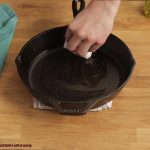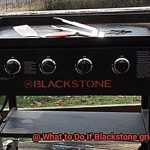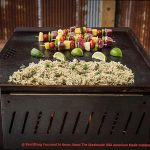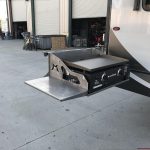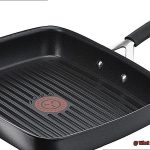Do you want to get the most out of your Blackstone Griddle Press? Seasoning it properly is the key. With this blog post, you’ll learn all about why it’s important to season your griddle press, as well as step-by-step instructions for doing so. Plus, we’ll answer some common questions and provide tips for keeping your griddle in tip-top shape.
Cooking with a Blackstone Griddle Press can be a great way to make delicious meals for family and friends. It’s versatile enough to make everything from breakfast cereals to burgers and steaks.
But before you start cooking, it’s essential that you season your Blackstone Griddle Press correctly. This will help keep the griddle in good condition and ensure that every meal tastes delicious.
So if you’re ready to learn how to season a Blackstone Griddle Press, read on.
Contents
What Is the Best Oil to Use When Seasoning a Blackstone Griddle Press?
Choosing the right oil is key to achieving a successful season.
Vegetable oil is your go-to choice for seasoning a Blackstone griddle press. It has an impressively high smoke point of around 400-450°F, making it ideal for creating a non-stick surface. Canola oil, grapeseed oil, and peanut oil are also suitable options as they all have similar smoke points.
When seasoning your Blackstone griddle press, it’s important to avoid using butter or other animal-based fats. These fats have low smoke points and can burn quickly, leaving behind an unpleasant sticky residue on the press’s surface. Additionally, using low-smoke-point oils like olive oil or flaxseed oil can result in a gummy finish on your press.
To season your Blackstone griddle press, lightly coat the surface with your chosen oil and wipe off any excess with a clean paper towel. Heat the press on the griddle until the oil begins to smoke before turning off the heat and allowing it to cool. Repeat this process several times until you achieve a dark and glossy finish.
In conclusion, vegetable oil is the best option when it comes to seasoning a Blackstone griddle press. Canola oil, grapeseed oil, and peanut oils are also suitable choices as they all have similar smoke points.
However, it is important to avoid using butter or other animal-based fats as well as low-smoke-point oils like olive oil or flaxseed oils as these can result in an undesirable finish.
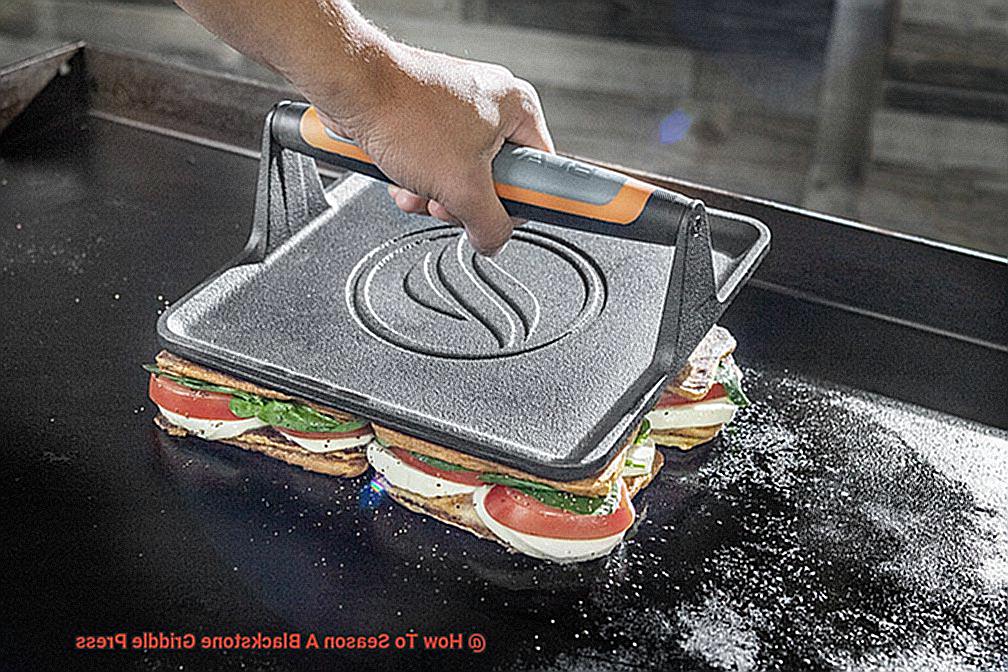
How To Clean Your Blackstone Griddle Press Before Seasoning
Scraping Food Remains
Before seasoning your Blackstone griddle press, it is essential to clean any food remains and debris. To do this, use a scraper or spatula to carefully remove any stuck-on particles from the surface. Be sure not to damage the press as you do this.
Keep Your Griddle Press in Tip-Top Shape
Next, use a mild soap and warm water to give your griddle press a thorough cleaning. Use a soft sponge or scrubber to remove any grease or stains, but avoid using any abrasive cleaners that could scratch the surface. After cleaning, rinse the griddle press with hot water and dry it with a soft cloth or paper towel to remove all moisture and prevent rusting.
Oiling It Up
To further protect your griddle press against rusting, lightly oil it after cleaning with either vegetable oil or any food-grade oil. Simply pour a small amount of oil onto a paper towel and wipe the surface of the press lightly. This will help keep your griddle press in tip-top shape for years of delicious meals cooked on it.
It’s time to season
Now that your griddle press is clean and ready, it’s time to season it so you can enjoy delectable meals cooked on your Blackstone griddle press. Seasoning will create an even non-stick surface that will make cooking faster and more enjoyable than ever before.
Follow Manufacturer Instructions for Best Results
For best results when seasoning your Blackstone griddle press, make sure to follow all manufacturer instructions carefully.
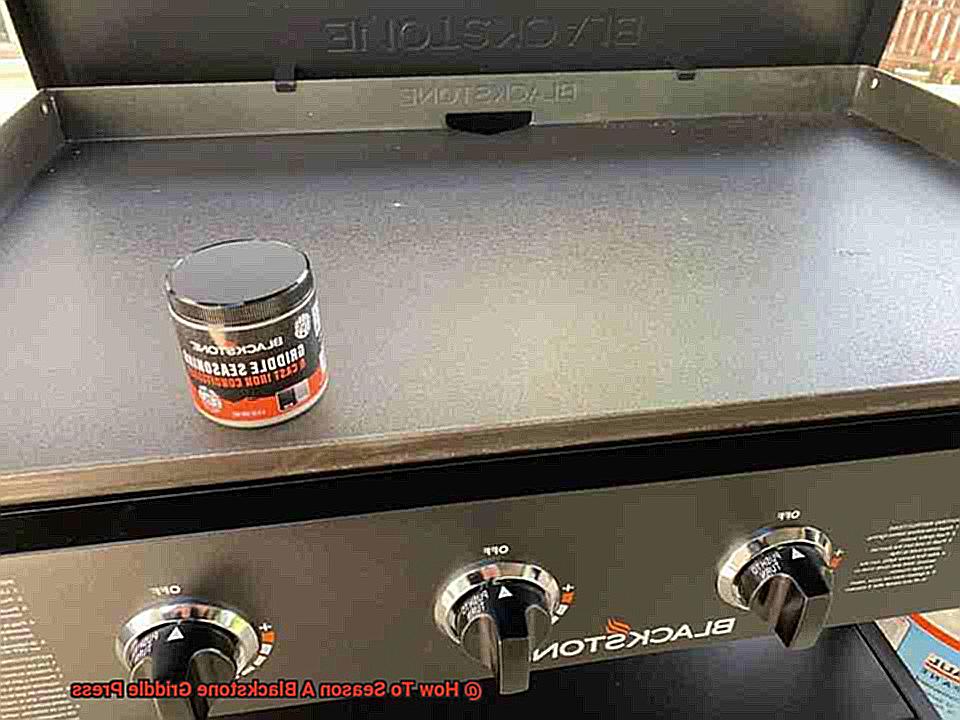
How To Season a Blackstone Griddle Press: Step-by-Step Guide
Seasoning it is key. This simple step will help to ensure a non-stick surface that will make cooking quicker and more enjoyable, as well as extend the life of your press. Here’s a step-by-step guide to seasoning your griddle press.
Begin by cleaning the press with warm soapy water and a soft sponge. Once it is clean and dry, apply a thin layer of oil, such as vegetable oil or canola oil, over the entire surface of the press using a paper towel or brush, depending on the type of oil. Make sure to get into all the crevices and corners.
Next, place your griddle press on the hot griddle and let it heat up for at least 15-20 minutes. You may detect smoke and heat emanating from the press during this period; this is normal. Repeat this process until you have achieved a smooth, shiny finish.
Tips and Tricks for Successfully Seasoning Your Blackstone Griddle Press
Cooking with a Blackstone griddle press is an enjoyable and flavorful way to prepare meals, but it’s essential to season the press correctly in order to get the best results. Here are five tips and tricks for successfully seasoning your Blackstone griddle press, so you can get the most out of your cooking experience.
Choose the Right Oil
When it comes to seasoning your Blackstone griddle press, opt for an oil with a high smoke point, such as flaxseed or avocado oil. This will ensure that the oil does not break down and leave a sticky residue on the surface.
Clean Thoroughly
Before seasoning your griddle press, make sure it is clean and free of any dust or debris. A combination of warm water, vinegar, and mild soap will do the trick.
Apply Evenly
Once your griddle is clean and dry, begin seasoning it by applying a thin layer of oil to both sides of the press using a paper towel or cloth. Be sure not to use too much oil so that it does not result in an overly greasy surface.
Heat It Up
Place your seasoned griddle on your preheated stovetop or griddle and let it heat up for a few minutes until you see some smoke emanating from it. On your Blackstone griddle press, this will help bind the oil to the metal and create a non-stick surface.
Repeat as Needed
To achieve optimal results, repeat this process three times before using your Blackstone griddle press for cooking. This will help build up a durable seasoning layer on the surface so that food will not stick when you’re making delicious meals.
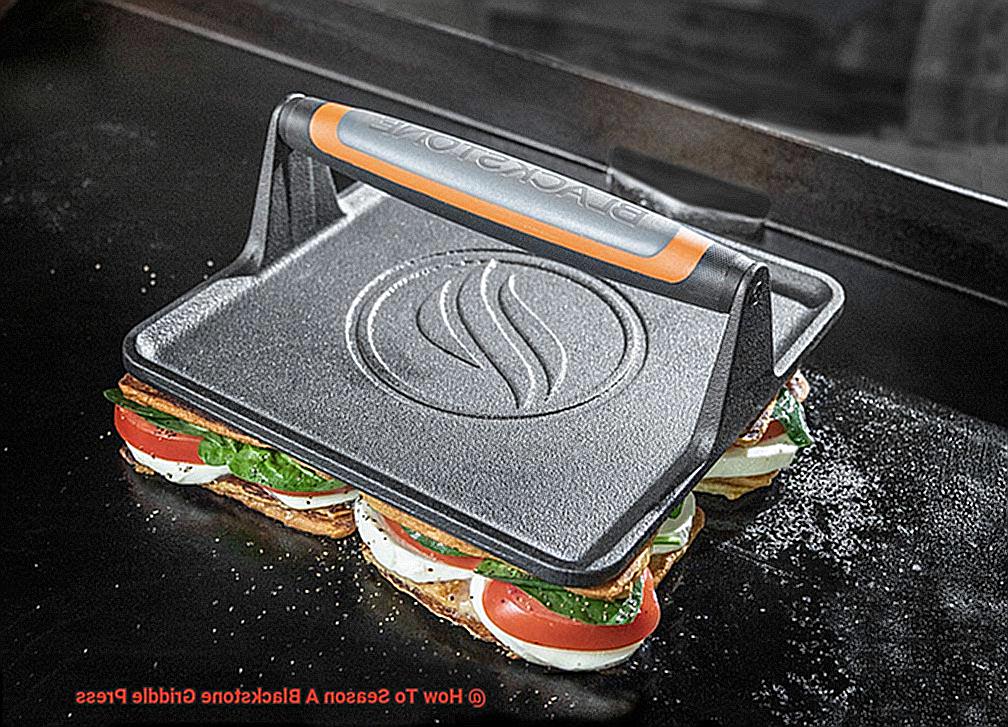
How Often Should You Re-Season Your Blackstone Griddle Press?
Keeping your Blackstone griddle press in top condition is essential for perfect cooking results. Re-seasoning your press regularly not only helps to create a non-stick surface, but also prevents rust and other damage. Contrary to popular belief, it’s important to re-season your griddle press more than once.
As a general rule of thumb, re-seasoning should be done every few months or after a long period of non-use.
To do this, start by heating the press up until it reaches a high temperature. Then, apply a thin layer of oil with a high smoke point such as canola or vegetable oil and let it sit for several minutes before wiping away any excess with a clean paper towel.
Finally, use a dry cloth to buff the surface and give it a nice shine.
In addition to re-seasoning your griddle press, make sure you clean it well after each use.
Wipe down the surface with a clean cloth or paper towel and remove any food particles or debris that may have accumulated during cooking.
If necessary, use mild soap and warm water to clean the press before drying it completely before using again.
What If My Blackstone Griddle Press Does Not Need to be Seasoned?
When it comes to seasoning your Blackstone griddle press, the decision is yours. While it isn’t necessary, it can add flavor and protection to the surface. To season your press, apply a thin layer of oil, heat on medium-high for 10-15 minutes and allow to cool.
This process can be repeated a few times before using the press for the first time.
On the other hand, if you choose not to season your griddle press, make sure you clean it after each use with soap and water or a cloth with vinegar and water. Additionally, store the press in a dry area to avoid moisture buildup over time.
Common Mistakes to Avoid When Seasoning a Blackstone Griddle Press
When it comes to preserving your Blackstone griddle press, proper seasoning is key. Making mistakes during the seasoning process can lead to a sticky paste or even damage the surface of your griddle press.
To ensure that your press is properly prepared, here are some common mistakes to avoid when seasoning a Blackstone griddle press.
First, be sure to use the right oil for seasoning. Flaxseed oil has a high smoking point and creates a non-stick surface for your griddle press.
Avoid using vegetable oil or other oils at low smoke levels as they can leave a sticky residue on the surface of the press.
It’s also essential to preheat the griddle before seasoning it. Preheating ensures that the oil is evenly distributed and helps reduce sticking, which in turn keeps food from sticking and makes cleaning easier.
Additionally, make sure you clean the griddle thoroughly before seasoning it; any leftover debris or oil can create hot spots and affect how well it performs.
Proper Cleaning of Your Blackstone Griddle After It Is Seasoned
Keeping your blackstone griddle in pristine condition is essential for a long-lasting and top quality cooking experience. After each use, it’s imperative to scrape off any debris and food particles with a scraper and hot water. This ensures a spotless surface for your next meal.
Be sure to only use plastic or wooden utensils when handling the griddle, as metal utensils could scratch the non-stick surface and reduce its effectiveness. To avoid rusting, dry the griddle thoroughly after washing with a towel or heat it up for a few minutes to remove any moisture.
Additionally, store your blackstone griddle in a dry and cool place to prevent oxidation or other damage. For extra protection, you can apply a light coating of oil after cleaning the griddle to maintain its seasoning.


